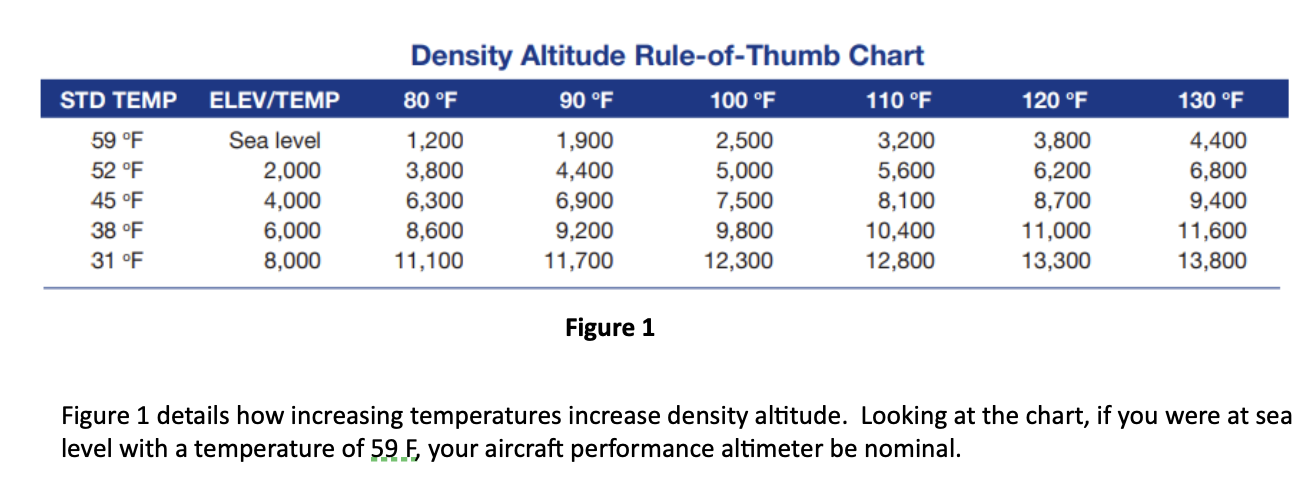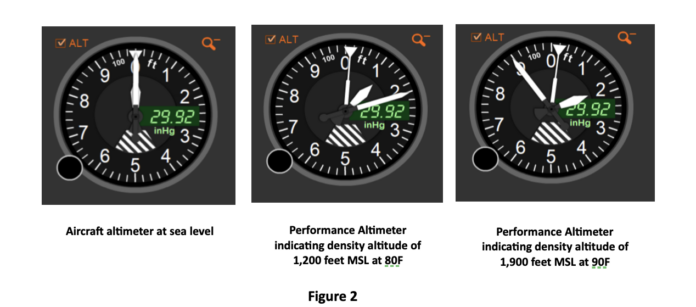This is the second of a two-article series on density altitude and aircraft performance, focusing on other factors such as rate of climb, angle of climb and takeoff performance.
“I don’t get no respect.”
Comedian Rodney Dangerfield’s catchphrase is also apt for the topic of density altitude. It’s something we first learn in ab initio training, again during commercial pilot classes, and then it becomes one of those terms we recognize but don’t pay much attention to. How often before a flight have you heard someone ask, “What is our density altitude?”.
It is a question well worth answering. Using the Search box at the NTSB home page cites various accident/incident reports neglecting high density altitudes as causative factors. The FAA also recognizes the issue: “Hot, high, and humid weather conditions can cause a routine takeoff or landing to become an accident in less time than it takes to tell about it.” (FAA-P-8740-2 AFS-8(2008) HQ-08561).
Knowing the density altitude where you are operating is vital because it provides an important heads up on how your aircraft will perform under present atmospheric conditions, covering factors such as takeoff roll, rate of climb and angle of climb that are handy to know to stay out of trouble. We all know from practical experience that as temperatures rise, aircraft performance drops. The key here is to understand how much performance decreases ahead of time and how to adjust operations to deal with that decrease.
Unfortunately, there is no ‘density altitude meter’ (more on this later) to make things easy. Still, it must be calculated and used to predict aircraft performance in all phases of flight.
Figure 1 details how increasing temperatures increase density altitude. Looking at the chart, your aircraft performance altimeter is nominal if you were at sea level with a temperature of 59 F.
If the temperature rose to 80 F, your aircraft performance would be as though you were at 1,200 feet MSL. The hotter it gets, the more aircraft performance suffers.
What does that mean in real terms? A normally aspirated aircraft engine will lose approximately 3.5 percent of its horsepower for every 1,000-foot increase in density altitude. So, at a density altitude of 1,200 feet, 3.5 x 1.2 = 6.65 percent reduction in power occurs.
Both lift and propeller thrust decrease by approximately 2.7 percent per thousand feet, adding yet more to the performance decrease.
And last but not least, add to that equation the rule of thumb that a 10 percent increase in takeoff gross weight would cause:
- a 5 percent increase in takeoff velocity
- a 9 percent decrease in the rate of acceleration
- at least a 21 percent increase in takeoff distance
Altogether, that’s a lot of performance decrease, even when you’re only talking about a 1000-foot difference in altitude. It can make for some exciting moments as you climb over large transmission lines or climb above rising terrain, large trees, or other obstacles coming your way.
Add working in high temperatures off an airstrip a couple of thousand feet above your home strip; you really need to crunch some numbers to establish a safe load.
Effect of Humidity on Density Altitude
Some water vapor is usually present in the air unless you are in the middle of a vast desert. Water vapor is lighter than air; consequently, moist air is lighter than dry air. As the humidity increases, the air becomes less dense, decreasing performance.
While there are usually charts in the POH detailing how pressure and temperature influence aircraft performance, no rule-of-thumb or chart is used to compute the effects of humidity, but it must be considered. Expect a decrease in overall performance in high humidity conditions, for instance, on cool mornings when the propeller tip vortices produce a visible condensation ring at high RPM, indicating high humidity.

The 4 H’s
Remember those factors collectively as the 4H’s: hot, high, heavy and humid. Together they can really bring about a significant overall decrease in performance. If you find yourself in a situation where the 4 H’s are abundant, look closely at expected aircraft performance and adjust the load accordingly, either by reducing hopper or fuel load or a combination of both.
The Performance Altimeter
Imagine that in addition to the standard altimeter, you have a ‘performance altimeter’ (Figure 2) that computes and displays density altitude, telling you that your aircraft will perform as though it were at that altitude rather than your actual altitude MSL. See the diagram below. To make it complete, the performance altimeter would also indicate the decrease in power and thrust your aircraft will experience. It gives you a real-time indication of the performance decrease you can expect—excellent information to know when the going gets tough.
The FAA Agrees
Taking into account density altitude is mandatory for accurate prediction of aircraft performance. As the FAA Handbook of Aeronautical Knowledge points out, “the most critical conditions of takeoff performance are the result of some combination of high gross weight, altitude, temperature, and unfavorable wind. In all cases, the pilot must accurately predict takeoff distance from the performance data of the AFM/POH”.
If that information is not available, prudence is the better part of valor. Go light, go easy, or just shut down until conditions get more agreeable to safe operations.
How to Avoid the 4 H’s
Keep a chart (like the density altitude rule of thumb one above) handy to quickly check out density altitude. Or use the National Weather Service calculator at Density Altitude Calculator (weather.gov).
If you don’t already have one, add a section to your Flight Operations Manual covering density altitude’s performance effect. You can use that to study and refresh your memory regarding off-season study.
Whatever aircraft you are operating, adjust the load size to compensate for increases in density altitude. For example, if you’re flying an AT-401 and using a standard load of 360 gallons, reduce that to 320 gallons whenever a specific temperature is reached, depending on your experience with that aircraft.
Remember, the 4 H’s – high, hot, heavy, and humid – are not where you want to be.





